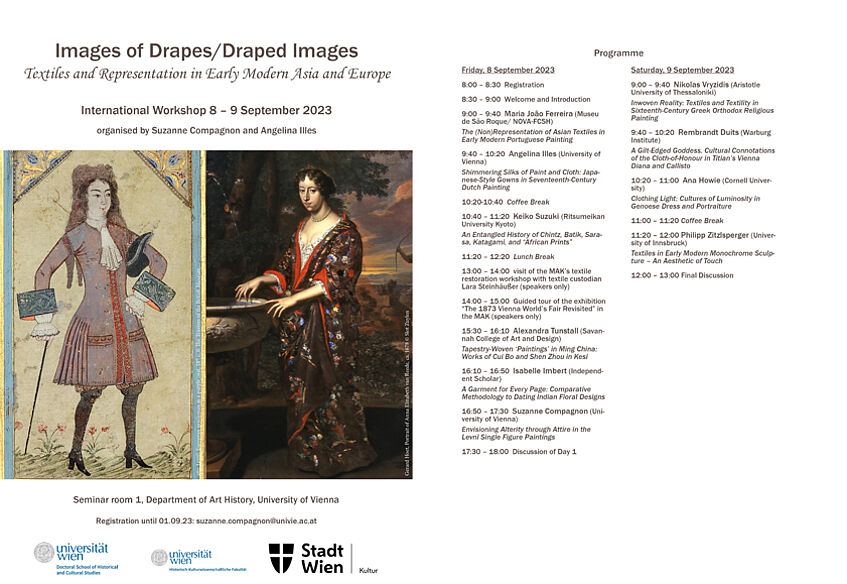Images of Drapes/Draped Images: Textiles and Representation in Early Modern Asia and Europe
International Workshop, 8-9 September 2023

The relationship between images and textiles are rarely considered in scholarship. When images of textiles are taken into account in textile history, they are often only used as visual documentation for clothing practices or as a tool to date textile objects. In contrast, scholars working on pictorial arts study representations of textiles as part of the larger context of the artwork rather than necessarily studying them for their own sake. Each approach has its advantages, but both have in common that they only offer a partial analysis of these depictions. Yet, images of textiles and textiles with images highlight a number of interesting points. Both textiles and their representations in the early modern period can only be understood within a larger context of transregional exchanges. Thus, the workshop wishes to discuss case-studies from early modern Asia and Europe. This interdisciplinary approach also supports comparatives discussions which help to fully appreciate the variety of artistic practices in their singularity.
The first set of issues this workshop wishes to tackle relate to the theme of visual culture. Representations of textiles raise the question of the sources of inspiration for these images. Interrogating the link between these visual creations and the contemporary material and visual culture helps to understand how depicted textile objects intersect with social practices and intellectual constructions. In addition, it paves the way for outlining how these pictorial representations in turn also shaped these societies. These points are particularly salient in a cross-cultural and transregional perspective. The issue of artists’ and patrons’ access and knowledge of textiles produced in foreign cultural contexts needs to be investigated to fully grasp their meanings in representations. When considering textiles as supports for images, the issue of the sources is just as relevant.
The workshop’s second set of questions centres on medium and materiality. Given the prominence of materiality in analysing fabrics’ cultural importance, one wonders if this is also the case in images of these objects. In fact, the act of pictorial representation implies a transformation of textile objects since it gives primacy to vision, effectively limiting the sensory experience of textiles to a visual one, or a visually mediated one. If the physical intimacy created by textiles’ haptic qualities is absent from images, it has the potential to alter the role or the significance of an image by the very fact that it is on a fabric. On another level, it is also important to discuss processes of image adaptation. This includes the manner in which the three-dimensional nature of woven structures allows for visual effects not possible in pictorial media.
The workshop engages with the following questions:
- What were the sources of inspiration for representations of textiles? Were they the product of the artist’s imagination? Did they draw on existing textile products and their designs?
- What role does the textiles’ materiality play in their representation? How is the materiality of textiles depicted across various media and artistic traditions?
- How are images from other media integrated into textiles objects? What impact do the physical properties of specific materials and techniques relating to the production of textiles have on the images they carry?
- What is the relationship between the socio-historical value of textiles and their pictorial representation or translation in other forms of art? How central are textiles to images’ representative function and images to textiles’ representative function?
Date & Venue: 8-9 September 2023, SR 1, Department of Art History, University of Vienna
Organization: Suzanne Compagnon and Angelina Illes
Registration: Please send an email to Suzanne Compagnon until 1 September 2023.
Friday, 8 September 2023
8:00 – 8:30 Registration
8:30 – 9:00 Welcome and Introduction
9:00 – 9:40 Maria João Ferreira (Museu de São Roque/ NOVA-FCSH): The (Non)Representation of Asian Textiles in Early Modern Portuguese Painting
9:40 – 10:20 Angelina Illes (University of Vienna): Shimmering Silks of Paint and Cloth: Japanese-Style Gowns in Seventeenth-Century Dutch Painting
10:20-10:40 Coffee Break
10:40 – 11:20 Keiko Suzuki (Ritsumeikan University Kyoto): An Entangled History of Chintz, Batik, Sarasa, Katagami, and “African Prints”
11:20 – 12:20 Lunch Break
13:00 – 14:00 Visit of the MAK textile storage and restoration workshop with textile custodian Lara Steinhäußer (speakers only)
14:00 – 15:00 Guided tour of the MAK collections (speakers only)
15:30 – 16:10 Alexandra Tunstall (Savannah College of Art and Design): Tapestry-Woven 'Paintings' in Ming China: Works of Cui Bo and Shen Zhou in Kesi
16:10 – 16:50 Isabelle Imbert (Independent Scholar): A Garment for Every Page: Comparative Methodology to Dating Indian Floral Designs
16:50 – 17:30 Suzanne Compagnon (University of Vienna): Envisioning Alterity through Attire in the Levnī Single Figure Paintings
17:30 – 18:00 Discussion of Day 1
Saturday, 9 September 2023
9:00 – 9:40 Nikolas Vryzidis (Aristotle University of Thessaloniki): Inwoven Reality: Textiles and Textility in Sixteenth-Century Greek Orthodox Religious Painting
9:40 – 10:20 Rembrandt Duits (Warburg Institute): A Gilt-Edged Goddess. Cultural Connotations of the Cloth-of-Honour in Titian's Vienna Diana and Callisto
10:20 – 11:00 Ana Howie (Cornell University): Clothing Light: Cultures of Luminosity in Genoese Dress and Portraiture
11:00 – 11:20 Coffee Break
11:20 – 12:00 Philipp Zitzlsperger (University of Innsbruck): Textiles in Early Modern Monochrome Sculpture – An Aesthetic of Touch
12:00 – 13:00 Final Discussion
